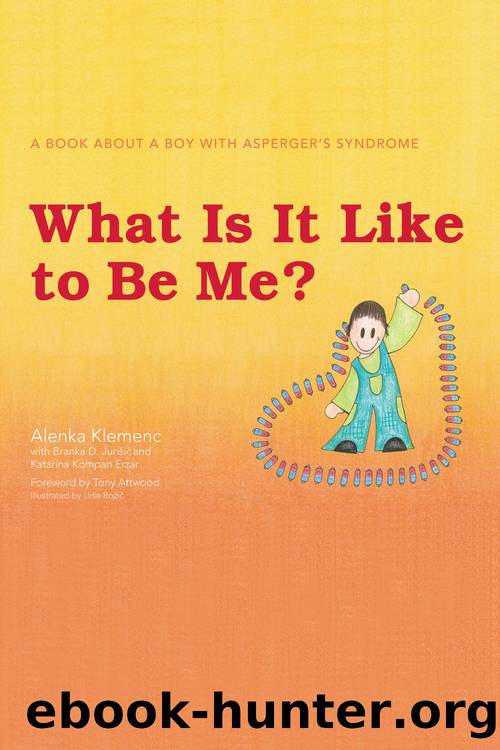What Is It Like to Be Me? by Dr Anthony Attwood

Author:Dr Anthony Attwood
Language: eng
Format: epub
Publisher: Jessica Kingsley Publishers
Published: 2013-04-15T00:00:00+00:00
1.Poor prosody (although inflection and intonation may not be as rigid and monotonic as with autism). Verbal expression has a restricted range of intonation patterns with little regard to the communicative functioning of what is being said (assertions of fact, humorous remarks, etc.). The speech tempo may also be unusual (e.g. too fast and jerky), with frequent deviations in volume (e.g. speaking too loudly or too quietly with no regard to the environment, such as in a library or in a noisy crowd).
2.Speech may often be tangential and circumstantial, conveying a sense of looseness of associations and incoherence. People with AS may speak on a particular topic without adapting it to the interest and knowledge of the other person.
3.The conversational style of people with AS is characterized by marked verbosity when talking about their particular field of interest. They disregard the other party in a conversation and are unable to change the topic of the conversation, and their narrative often takes the form of a long monologue or a boring lecture.
Restricted fields of interest
People with AS may be highly knowledgeable about a particular topic, which may change as time passes, and which they will often talk about in social contacts. At the same time, a person with AS may lack an understanding of the context and a wider view of the particular phenomenon (names of constellations, types of washing machines, personal details of celebrities, etc.). This is a symptom that is not always easy to identify in children with AS, since their interests are not necessarily dissimilar to those of other children. These children, however, stand out in that their narrow field of interest occupies them to the point of neglecting other areas of learning, since all their attention and motivation is concentrated on a single topic. This may also limit socializing and communication with others, since the narrow field of interest dominates their communication to the point of not being able to exchange other information. It is not a good idea to stop children with AS from occupying themselves with subjects that interest them; however, it is advisable to attempt to limit them and link them to less popular but unavoidable activities. Special interests can be a powerful tool in motivating work completion and encouraging appropriate behavior, and in easing anxiety caused by daily activities. This could be just a simple rule: âAfter you have done your homework/put away your clothes/eaten your lunch, we will talk for ten minutes about what you like/you can arrange your cards.â Through their special interests, children with AS can also do amazing things and they should be encouraged and supported in these interests because they have the potential to have an impact on every area of a childâs lifeâfor example, identity, home, school, community and development of future careers (Winter-Messiers et al., 2007).
Motoric difficulties
People with AS often are physically clumsy, have an odd body posture and demonstrate poor coordination of movement and balance problems. They may also have impaired fine motor skills or hand dexterity; in other words, their visual-motor integration and handwriting skills are poor.
Download
This site does not store any files on its server. We only index and link to content provided by other sites. Please contact the content providers to delete copyright contents if any and email us, we'll remove relevant links or contents immediately.
| Abuse | Death & Dying |
| Disaster Preparedness | Drugs |
| Dysfunctional Relationships | Homelessness & Poverty |
| Illness | Prejudice & Racism |
| Runaways | Violence |
Gamestorming The Way Forward by Priya Sarin(324)
The Catastrophic Friendship Fails of Lottie Brooks by Katie Kirby(301)
VA0208 Philip Pullman by Il Conte Karlstein(277)
L. M. Montgomery â Premium Collection by Lucy Maud Montgomery(232)
Double Jeopardy by Franklin W. Dixon(228)
Tale of a Tall Girl (Unfinished Fairy Tales) by Ling Aya(221)
The Crimson Thread by Roy J. Snell(211)
Aya and the Firecats by Gunhild Jensen(203)
Knights and Bikes by Gabrielle Kent(199)
Grover's Guide to Good Eating by Naomi Kleinberg(198)
The Boy With Wings by Lenny Henry(198)
The Mammoth Adventure by Philippa Gregory(192)
Courage, Dana by Susan Beth Pfeffer(185)
The Lost Gargoyle Series 3-Book Bundle by Philippa Dowding(185)
The Magic Thief Complete Collection by Sarah Prineas(180)
Tick Talk by Renée Wehrle(173)
A Baby's Guide to Surviving Mom by Benjamin Bird(172)
Missing Magic by Emma Laybourn(169)
Drooling Dudley by Shelley Swanson Sateren(167)
